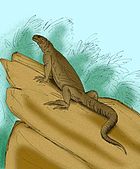Lapitiguana: Difference between revisions
| [pending revision] | [accepted revision] |
Content deleted Content added
No edit summary Tags: Mobile edit Mobile web edit |
No edit summary |
||
| (46 intermediate revisions by 33 users not shown) | |||
| Line 1: | Line 1: | ||
{{Short description|Extinct genus of lizards}} |
|||
{{pp-pc1}} |
|||
{{speciesbox |
{{speciesbox |
||
| fossil_range = |
| fossil_range = [[Holocene]]{{fossilrange|.011|.003|}} |
||
| image = Lapitiguana impensa.JPG |
| image = Lapitiguana impensa.JPG |
||
| image_caption = |
| image_caption =''[[Viti Levu giant pigeon|Natunaornis]]'' and ''Lapitiguana'' |
||
| genus = Lapitiguana |
| genus = Lapitiguana |
||
| parent_authority = |
| parent_authority = |
||
| Line 10: | Line 13: | ||
'''''Lapitiguana impensa''''' is an [[extinction|extinct]] giant (1.5 m long) [[iguanid]] from [[Fiji]].<ref name = "Pregill">{{Cite journal |
'''''Lapitiguana impensa''''' is an [[extinction|extinct]] giant (1.5 m long) [[iguanid]] from [[Fiji]].<ref name = "Pregill">{{Cite journal |
||
| last = Pregill | first = G. K. |
| last = Pregill | first = G. K. |author2=Worthy, T. H. |
||
| title = A New Iguanid Lizard (Squamata, Iguanidae) from the Late Quaternary of Fiji, Southwest Pacific |
| title = A New Iguanid Lizard (Squamata, Iguanidae) from the Late Quaternary of Fiji, Southwest Pacific |
||
| journal = Herpetologica | volume = 59 | issue = 1 | pages = 57–67 |
| journal = Herpetologica | volume = 59 | issue = 1 | pages = 57–67 |
||
| publisher = The Herpetologists' League |
| publisher = The Herpetologists' League | date = March 2003 | url = https://www.academia.edu/601893| doi = 10.1655/0018-0831(2003)059[0057:ANILSI]2.0.CO;2 }}</ref> It probably became extinct following the human colonization of Fiji 3000 years ago.<ref name = "Pregill"/> |
||
All extant Fijian iguanas are in the genus ''[[Brachylophus]]'', together with an [[Brachylophus gibbonsi|extinct species from Tonga]]. The closest living relatives of the [[Polynesia]]n iguanas are found in the Americas |
All extant Fijian iguanas are in the genus ''[[Brachylophus]]'', together with an [[Brachylophus gibbonsi|extinct species from Tonga]]. The closest living relatives of the [[Polynesia]]n iguanas are found in the Americas.<ref name = "Keogh">{{Cite journal | last = Keogh | first = J. Scott |author2=Edwards, Danielle L. |author3=Fisher, Robert N. |author4=Harlow, Peter S. |
||
| title = Molecular and morphological analysis of the critically endangered Fijian iguanas reveals cryptic diversity and a complex biogeographic history |
| title = Molecular and morphological analysis of the critically endangered Fijian iguanas reveals cryptic diversity and a complex biogeographic history |
||
| journal = [[Philosophical Transactions of the Royal Society B]] | volume = 363 | issue = 1508 | pages = 3413–3426 |
| journal = [[Philosophical Transactions of the Royal Society B]] | volume = 363 | issue = 1508 | pages = 3413–3426 |
||
| publisher = [[Royal Society]] |
| publisher = [[Royal Society]] | date = 2008-10-27 |
||
| doi = 10.1098/rstb.2008.0120 |
|||
| pmid=18782726 | pmc=2607380}}</ref><ref name="Noonan">{{cite journal|author1=Noonan, B.P. |author2=Sites, J.W. Jr.|date= 2009-11-24|title=Tracing the origins of iguanid lizards and boine snakes of the Pacific|publisher=[[University of Chicago Press]]|pages=61–72|doi=10.1086/648607|volume=175 |pmid=19929634 |issue=1 |journal=[[The American Naturalist]]|s2cid=5882832}}</ref> |
|||
==See also== |
==See also== |
||
| Line 40: | Line 43: | ||
[[Category:Quaternary reptiles]] |
[[Category:Quaternary reptiles]] |
||
[[Category:Iguanidae]] |
[[Category:Iguanidae]] |
||
[[Category: |
[[Category:Reptiles of Fiji]] |
||
[[Category:Fossil taxa described in 2003]] |
[[Category:Fossil taxa described in 2003]] |
||
[[Category:Reptile genera]] |
[[Category:Reptile genera]] |
||
[[Category:Holocene extinctions]] |
|||
Latest revision as of 00:38, 17 September 2022
| Lapitiguana Temporal range: Holocene
| |
|---|---|

| |
| Natunaornis and Lapitiguana | |
| Scientific classification | |
| Domain: | Eukaryota |
| Kingdom: | Animalia |
| Phylum: | Chordata |
| Class: | Reptilia |
| Order: | Squamata |
| Suborder: | Iguania |
| Family: | Iguanidae |
| Genus: | †Lapitiguana |
| Species: | †L. impensa
|
| Binomial name | |
| †Lapitiguana impensa Pregill & Worthy, 2003
| |
Lapitiguana impensa is an extinct giant (1.5 m long) iguanid from Fiji.[1] It probably became extinct following the human colonization of Fiji 3000 years ago.[1]
All extant Fijian iguanas are in the genus Brachylophus, together with an extinct species from Tonga. The closest living relatives of the Polynesian iguanas are found in the Americas.[2][3]
See also[edit]
References[edit]
- ^ a b Pregill, G. K.; Worthy, T. H. (March 2003). "A New Iguanid Lizard (Squamata, Iguanidae) from the Late Quaternary of Fiji, Southwest Pacific". Herpetologica. 59 (1). The Herpetologists' League: 57–67. doi:10.1655/0018-0831(2003)059[0057:ANILSI]2.0.CO;2.
- ^ Keogh, J. Scott; Edwards, Danielle L.; Fisher, Robert N.; Harlow, Peter S. (2008-10-27). "Molecular and morphological analysis of the critically endangered Fijian iguanas reveals cryptic diversity and a complex biogeographic history". Philosophical Transactions of the Royal Society B. 363 (1508). Royal Society: 3413–3426. doi:10.1098/rstb.2008.0120. PMC 2607380. PMID 18782726.
- ^ Noonan, B.P.; Sites, J.W. Jr. (2009-11-24). "Tracing the origins of iguanid lizards and boine snakes of the Pacific". The American Naturalist. 175 (1). University of Chicago Press: 61–72. doi:10.1086/648607. PMID 19929634. S2CID 5882832.
External links[edit]





